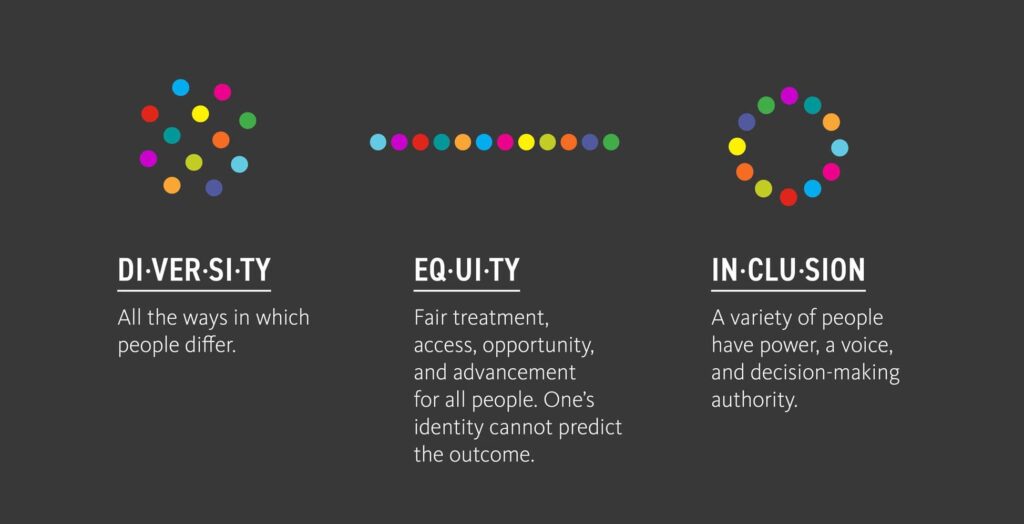Since the late 1990s, we have seen a new wave of values-driven businesspeople who are embracing DEI. The positive outcomes of well-designed DEI programs are easier to prove now than they were even a few years ago.

- Legal compliance
DEI programs have grown and evolved to be less about legal compliance and more about impacting real cultural change. DEI programs are contributing to business bottom line and promoting employees’ successes. However, without the laws and regulations governing equal rights and outlawing discrimination, it is unlikely that DEI models would exist. So the first reason for implementing a DEI program is the need to comply with the law and avoid financial and reputational liabilities.
Implementing a DEI program in which you aim to diversify your workforce and focus on equity and fairness is likely to reduce the likelihood of exposure to legal claims.
The financial liability associated with discrimination-based litigation can be significant and, whilst the average employment tribunal award for successful discrimination cases is just under £30,000, there are examples of employment tribunals awarding compensation in the millions of pounds.
You can look to establish a defence to a claim that is brought against your business if you can show that you took all reasonable steps to prevent an alleged perpetrator from doing the alleged act of discrimination.
2. Aligning with the values of your business (the social justice case)
Over the past several years, equality focused social movements have had a huge impact on the national conversation. Factors such as gender pay reporting, growing public pressure, and widespread activism have led to attention being given to workplace disparities.
The social justice case is that a free and just society is one without barriers to equitable access and full participation by all in the benefits of that society. The social justice case for DEI is compelling and your business case may be principally based on achieving an alignment with your company values. Global fast-food chain, Shake Shack has a pledge to “Stand For Something Good” and its DEI strategy is aligned to that pledge. It has a “People-First Culture” and its website refers to its people being central to all of its decisions and that it actively works to foster an environment of ‘hope, optimism, affirmation and on-going learning’. It is also very open about its DEI goals. By 2025, it wants to have:
- 50% ‘people of color’ in its Leadership (currently 34.7%)
- Gender parity between men and women in its Leadership (currently 23.7%)
Nike has shown its commitment by tying executive compensation to ESG goals, which include reaching 50% representation of women in the company’s global corporate workforce and reaching 45% representation of women in leadership positions.
Times continue to change at a pace and a positive recent Canadian study (Blueprint: January 2022) revealed that men at all levels are now:
- more likely to speak out on issues of equity
- show a stronger commitment to challenge “inappropriate” behaviour in the workplace.
- more inclusive and empathic while also more cautious and less confident.
The study also found that female leaders are now regarded as equally charismatic, visionary, and strategic as male leaders, while being seen as more inclusive and empathic than male leaders.
Unfortunately, the report found some evidence of a ‘backlash’, with 10-13% of men expressing a very negative reaction to these social movements. Therefore, it has to be acknowledged and accepted that the social justice case does not convince everyone.
3. The commercial benefits
There is less noise these days about DEI as mere political correctness. Claims that initiatives to grow DEI do not work are being countered with lots of good evidence that they do. However, it is still a challenge to move businesses beyond good intentions and vague statements about mission and values that started to pop up on websites around the late 1990s/early 2000s.
You are likely to encounter leaders who will remind you that they are businesspeople, and not social justice advocates. For these people you will need to turn to the language of business.
According to Forbes magazine, unconscious bias in the workplace costs American businesses as much as $550 billion dollars every year.
One UK government report noted that Britain loses £24 billion annually in failing to bring talented Black, Asian, or minority ethnic professionals into the workplace.
Not losing out
Many businesses see the largest loss of revenue in recruitment. If you are perceived to lack diversity or inclusion you are more likely to struggle to attract or retain skilled candidates from minority groups. That is not all. If your business lacks diversity, you are not only losing the best possible minority candidates. A recent study by Weber Shandwick show that most millennials, regardless of whether they are minority candidates, search for jobs based on the diversity and inclusion of a business. This means that without a real focus on achieving diversity, equity and inclusion, you should not expect to attract the best possible candidates.
A 2019 Deloitte survey estimated that 63 percent of millennials would consider quitting if their employer didn’t prioritise diversity and inclusion.
The gains
The case for DEI is not only about avoiding losing out on the best people. Diverse businesses tend to survive and thrive for longer than their less diverse competitors.
Diverse teams are better at problem-solving than more homogenous groups. Diverse teams can leverage a greater variety of perspectives and are likely to consider information more thoroughly and accurately.
There are several reasons for this. Examples include the following:
- Problem-solving and decision making
In his book, The Diversity Bonus, University of Michigan professor and social scientist Scott Page looked at groups that represent cognitive diversity (differences in how we reason, interpret and solve problems). He found that different ways of thinking, which can be affected by identification with a particular group (gender, race, socioeconomic status, etc), produces ‘something extra’. When people with varying “tools” for solving complicated tasks come together and work inclusively to find solutions, the results are powerful.
Gender diversity is an important part of this equation. Christine Lagarde is the President of the European Central Bank. She was previously managing director of the International Monetary Fund and, whilst in that role, she said that better decisions are made when women and men come together at the table, creating what she calls a “larger horizon.” She backed her claim by referring to statistics. While women make up only 2% of bank CEO’s worldwide and only 20% of their boards, banks who count women among the top leadership tend to have better fiscal profiles and lower risk to the consumer.
Forbes conducted research in 2017 into inclusive decision making to understand just how much improvement is possible. The study analysed approximately 600 business decisions made by 200 different business teams in a wide variety of companies over two years, using the Cloverpop decision-making database. The research showed a direct link between inclusive decision making and better business performance. A summary of the findings are as follows:
- Inclusive teams make better business decisions up to 87% of the time.
- Teams that follow an inclusive process make decisions that are two times faster with half the meetings.
- Decisions made and executed by diverse teams delivered 60% better results
- Employee engagement
There is evidence that inclusion is closely linked to employee engagement, which is a critical component of:
- employee retention,
- productivity and
financial performance
The State of the Global Workplace report, conducted by Gallup has found that business units that score in the top quartile of their organisation in employee engagement have nearly double the odds of success. They are 17% more productive and 21% more profitable than those in the bottom quartile. They also have 20% higher sales and 10% higher customer metrics.
- Innovation
McKinsey & Company published a report in 2020 (Diversity Wins). It referred to evidence of diverse teams being more likely to radically innovate and anticipate shifts in consumer needs and consumption patterns that help companies to gain a competitive edge.
Research that was published in the Harvard Business Review, scrutinised two kinds of diversity: inherent and acquired.
- Inherent diversity: these are traits you are born with, such as gender, ethnicity, and sexual orientation.
- Acquired diversity: These are traits you gain from experience, such as working in another country that assist with an appreciation of cultural differences.
The research referred to companies whose leaders exhibit at least three inherent and three acquired diversity traits as having two-dimensional (2D) diversity.
By correlating diversity in leadership with market outcomes the researchers were able to conclude that companies with 2D diversity out-innovate and out-perform others. Employees at these companies are 45% more likely to report that their firm’s market share grew over the previous year and 70% more likely to report that the firm captured a new market.
The research tends to show that that 2D diversity unlocks innovation by creating an environment where “outside the box” ideas are heard.
4. The evidence
- More profitability
Analysis by McKinsey & Company in 2020 reaffirmed the strong business case for both gender diversity and ethnic and cultural diversity in corporate leadership.
“The most diverse companies are now more likely than ever to outperform non-diverse companies on profitability”.
McKinsey’s analysis found that companies in the top quartile of gender diversity on executive teams were 25 percent more likely to experience above-average profitability than peer companies in the fourth quartile and that the higher the representation, the higher the likelihood of outperformance.
In the case of ethnic and cultural diversity, the findings are equally compelling. McKinsey found that companies in the top quartile outperformed those in the fourth by 36 percent in terms of profitability.
- Better operating results
In a 2019 study conducted by the Wall Street Journal that ranked the diversity of 500 publicly traded domestic companies, the 20 most diverse companies had better operating results
- Better share performance
The same Wall Street Journal study found that, on average, the shares of the most diverse firms generally outperform those of the least-diverse firm. The top 20 most diverse companies had an average annual total return of 10 percent over five years and 14 percent over 10 years, versus 4.2 percent and 12 percent for the 20 least diverse companies.
